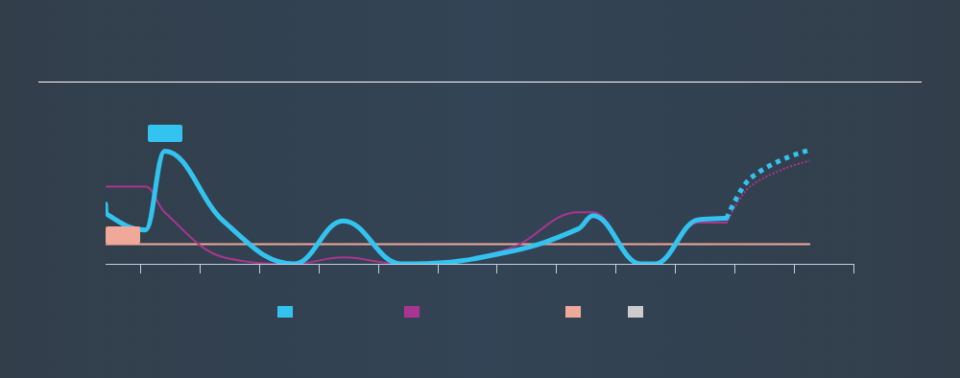Dalmia Bharat Sugar and Industries Limited's (NSE:DALMIASUG) 1.8% Dividend Yield Looks Pretty Interesting

Dividend paying stocks like Dalmia Bharat Sugar and Industries Limited (NSE:DALMIASUG) tend to be popular with investors, and for good reason - some research suggests a significant amount of all stock market returns come from reinvested dividends. Unfortunately, it's common for investors to be enticed in by the seemingly attractive yield, and lose money when the company has to cut its dividend payments.
A 1.8% yield is nothing to get excited about, but investors probably think the long payment history suggests Dalmia Bharat Sugar and Industries has some staying power. Some simple analysis can offer a lot of insights when buying a company for its dividend, and we'll go through this below.
Click the interactive chart for our full dividend analysis
Payout ratios
Companies (usually) pay dividends out of their earnings. If a company is paying more than it earns, the dividend might have to be cut. Comparing dividend payments to a company's net profit after tax is a simple way of reality-checking whether a dividend is sustainable. Looking at the data, we can see that 6.9% of Dalmia Bharat Sugar and Industries's profits were paid out as dividends in the last 12 months. Given the low payout ratio, it is hard to envision the dividend coming under threat, barring a catastrophe.
We also measure dividends paid against a company's levered free cash flow, to see if enough cash was generated to cover the dividend. Last year, Dalmia Bharat Sugar and Industries paid a dividend while reporting negative free cash flow. While there may be an explanation, we think this behaviour is generally not sustainable.
Is Dalmia Bharat Sugar and Industries's Balance Sheet Risky?
As Dalmia Bharat Sugar and Industries has a meaningful amount of debt, we need to check its balance sheet to see if the company might have debt risks. A quick check of its financial situation can be done with two ratios: net debt divided by EBITDA (earnings before interest, tax, depreciation and amortisation), and net interest cover. Net debt to EBITDA measures total debt load relative to company earnings (lower = less debt), while net interest cover measures the ability to pay interest on the debt (higher = greater ability to pay interest costs). With net debt of 1.81 times its EBITDA, Dalmia Bharat Sugar and Industries has an acceptable level of debt.
Net interest cover can be calculated by dividing earnings before interest and tax (EBIT) by the company's net interest expense. With EBIT of 2.74 times its interest expense, Dalmia Bharat Sugar and Industries's interest cover is starting to look a bit thin.
Remember, you can always get a snapshot of Dalmia Bharat Sugar and Industries's latest financial position, by checking our visualisation of its financial health.
Dividend Volatility
Before buying a stock for its income, we want to see if the dividends have been stable in the past, and if the company has a track record of maintaining its dividend. For the purpose of this article, we only scrutinise the last decade of Dalmia Bharat Sugar and Industries's dividend payments. The dividend has been cut by more than 20% on at least one occasion historically. During the past ten-year period, the first annual payment was ₹3.00 in 2009, compared to ₹1.60 last year. The dividend has shrunk at around 6.1% a year during that period. Dalmia Bharat Sugar and Industries's dividend has been cut sharply at least once, so it hasn't fallen by 6.1% every year, but this is a decent approximation of the long term change.
We struggle to make a case for buying Dalmia Bharat Sugar and Industries for its dividend, given that payments have shrunk over the past ten years.
Dividend Growth Potential
Given that dividend payments have been shrinking like a glacier in a warming world, we need to check if there are some bright spots on the horizon. Strong earnings per share (EPS) growth might encourage our interest in the company despite fluctuating dividends, which is why it's great to see Dalmia Bharat Sugar and Industries has grown its earnings per share at 128% per annum over the past five years. The company is only paying out a fraction of its earnings as dividends, and in the past been able to use the retained earnings to grow its profits rapidly - an ideal combination.
Conclusion
To summarise, shareholders should always check that Dalmia Bharat Sugar and Industries's dividends are affordable, that its dividend payments are relatively stable, and that it has decent prospects for growing its earnings and dividend. First, we like Dalmia Bharat Sugar and Industries's low dividend payout ratio, although we're a bit concerned that it paid out a substantially higher percentage of its free cash flow. Next, earnings growth has been good, but unfortunately the dividend has been cut at least once in the past. Ultimately, Dalmia Bharat Sugar and Industries comes up short on our dividend analysis. It's not that we think it is a bad company - just that there are likely more appealing dividend prospects out there on this analysis.
See if management have their own wealth at stake, by checking insider shareholdings in Dalmia Bharat Sugar and Industries stock.
We have also put together a list of global stocks with a market capitalisation above $1bn and yielding more 3%.
We aim to bring you long-term focused research analysis driven by fundamental data. Note that our analysis may not factor in the latest price-sensitive company announcements or qualitative material.
If you spot an error that warrants correction, please contact the editor at editorial-team@simplywallst.com. This article by Simply Wall St is general in nature. It does not constitute a recommendation to buy or sell any stock, and does not take account of your objectives, or your financial situation. Simply Wall St has no position in the stocks mentioned. Thank you for reading.


